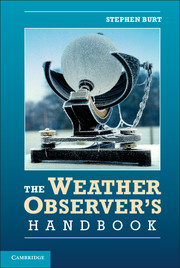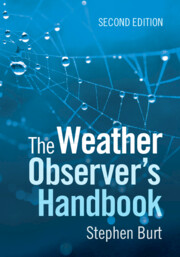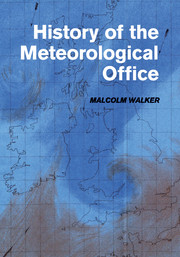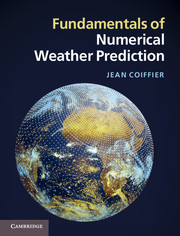The Weather Observer's Handbook
The Weather Observer's Handbook provides a comprehensive, practical and independent guide to all aspects of making weather observations. Automatic weather stations today form the mainstay of both amateur and professional weather observing networks around the world and yet – prior to this book – there existed no independent guide to their selection and use. Traditional and modern weather instruments are covered, including how best to choose and to site a weather station, how to get the best out of your equipment, how to store and analyse your records and how to share your observations with other people and across the Internet. From amateur observers looking for help in choosing their first weather instruments on a tight budget to professional observers looking for a comprehensive and up-to-date guide covering World Meteorological Organization recommendations on observing methods and practices, all will welcome this handbook.
- Unique and authoritative: information not available anywhere else in one place
- Global coverage
- Independent and comprehensive content
Reviews & endorsements
"This is a very impressive work! Stephen has done a great job of addressing many issues that I have personally wondered about. At last there is a comprehensive book on the tricky issue of accurately measuring the weather. This timely publication is a must for anyone in the market for a weather station, libraries, and weather observers of all stripes, both amateur and professional." - Christopher C. Burt, Weather Historian, Wunderground, Inc. and author of ‘Extreme Weather: A Guide and Record Book’
“Sophisticated equipment for weather observing is now within reach of more people than ever. Yet a poorly sited station or a wrongly interpreted report can do more harm than good. With this marvelous book, Stephen Burt has given us a very practical and helpful guide to installing and using one’s own reporting station, enhanced with perspective drawn from the centuries-long history of meteorological instrumentation. The Weather Observer’s Handbook is an ideal companion to the practice of monitoring the atmosphere.” - Robert Henson, author of The Rough Guide to Weather and The Rough Guide to Climate Change
“People have been making observations of the weather for thousands of years, and observations remain central to our capabilities to forecast the weather and predict the changing climate. But it's not just professional meteorologists who make weather observations: there are literally millions of amateur observers across the world making observations every minute of every day. In meteorology, as well as in other science disciplines, amateur observers (I include all non-professional meteorologists in this) have always played a crucial part in supporting well-established national observations programmes and in making a very valued contribution to our scientific understanding. We have many amateur members and schools in our Society and I'm often asked if I can recommend a good book to help them in their observing exploits: well now I can. This is the first comprehensive book of its type that I know of that offers a practical guide to anyone with an interest in making observations of the weather. It's not only an essential practical handbook, but it showcases the wide range of observations that can now be made with relative ease, and, importantly I think, it helps to enthuse others to follow their interest. If you have an interest in observing the weather then this book is as essential as your observing equipment.” - Paul Hardaker, Chief Executive of the Royal Meteorological Society
“I like this book very much. I am a life-long weather observer and user of weather data both as an amateur and a career professional - spanning the years from manual-only to globally-networked automated observing systems. This book answers so many of the questions I have had over the decades and the many questions I continue to field - from fresh beginners, to experienced amateurs and on to a wide range of professionals. At last I have a single book that I can point people to. It is comprehensive and scientifically rigorous - yet very readable. Thank you, Stephen - well done.” - Nolan Doesken, Colorado State Climatologist, former President of the American Association of State Climatologists, and founder and national director of the Community Collaborative Rain, Hail and Snow network (CoCoRaHS)
“ … the book’s great strength is that it draws on the author’s wealth of experience and expertise in making amateur measurements over several decades, and is liberally illustrated with photographs and data from his own weather station. … his enthusiasm for the subject … clearly comes across in the book. The author puts amateur weather enthusiasts at the head of his list of target audiences, and this is undoubtedly the group … who will find this very readable book a goldmine of information.” Geoff Jenkins, Weather
"The 'one minute summary' at the end of each chapter is particularly useful" - Sky at Night magazine, January 2013
"The strength of this book is that it does a good job of being a handy reference for any of its intended users (from backyard enthusiasts to professionals involved in research), as it has done a lot of the leg work for finding the appropriate instrument for the job. The “one-minute summary” at the end of most chapters gives a quick overview of the content and the extra thought put into making explanations clear and concise will be appreciated....I find this to be totally readable resource for anyone interested in the proper way to go about measuring the various elements of weather." - T. Colleen Farrell, CMOS Bulletin, February 2013
"I thoroughly enjoyed reading The Weather Observer’s Handbook by Stephen Burt, who has an impressive and diverse background in climatology, IT, and marketing. I would highly recommend this comprehensive weather-observing guide to hobbyists, professionals, teachers, and college instructors. The author has done an outstanding job making the book accessible to anyone interested in observing the weather, even if they do not have a technical background. At the same time, there is plenty of useful information for those of us who have been professionally involved in observing the weather for quite some time...Each chapter can be read on its own because any required background information from previous chapters is clearly referenced, making the book very user-friendly...overall the book offers accurate and useful information, and I highly recommend it." - Sytske Kimball, University of Southern Alabama, Bulletin of the American Meteorological Society, May 2013
"It would be difficult to find a more comprehensive book on the subject...for anyone thinking of investing in new instrumentation, or updating his or her existing instrumentation, this book is an essential pre-requisite." - Peter Rogers, International Journal of Meterology
Product details
June 2012Paperback
9781107662285
456 pages
254 × 177 × 19 mm
0.91kg
128 b/w illus. 2 maps 50 tables
Temporarily unavailable - available from TBC
Table of Contents
- Part I. The Basics:
- 1. Why measure the weather? A history of meteorological observations
- 2. Choosing a weather station
- 3. Buying a weather station
- 4. Site and exposure – the basics
- Part II. Measuring the Weather:
- 5. Measuring the temperature of the air
- 6. Measuring precipitation
- 7. Measuring atmospheric pressure
- 8. Measuring humidity
- 9. Measuring wind speed and direction
- 10. Measuring grass and earth temperature
- 11. Measuring sunshine and solar radiation
- 12. Observing hours and time standards
- 13. Dataloggers and AWS software
- 14. Non-instrumental weather observing
- 15. Calibration
- 16. Metadata – what is it, and why is it important?
- Part III. Making the Most of your Observations:
- 17. Collecting and storing data
- 18. Making sense of the data avalanche
- 19. Sharing your observations
- 20. Summary and getting started.







